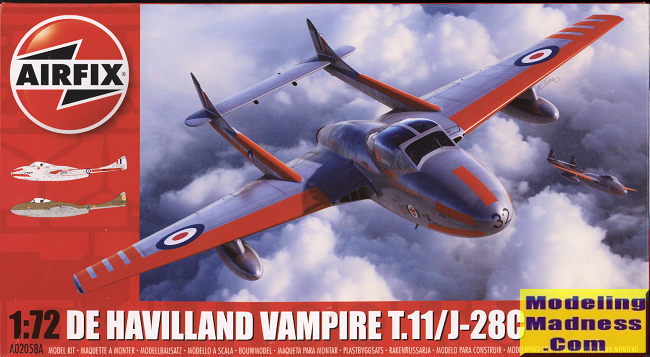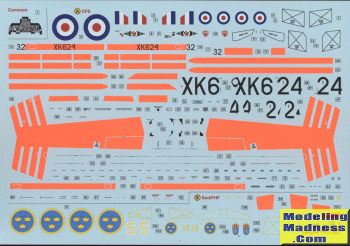
Airfix 1/72 Vampire T.11/J.28C
| KIT #: | A02058a |
| PRICE: | $13.99 SRP |
| DECALS: | Two options |
| REVIEWER: | Scott Van Aken |
| NOTES: | Reissue |

| HISTORY |
The de Havilland DH.100 Vampire was a British jet fighter commissioned by the Royal Air Force during the Second World War. Following the Gloster Meteor, it was the second jet fighter to enter service with the RAF. Although it arrived too late to see combat during the war, the Vampire served with front line RAF squadrons until 1953 and continued in use as a trainer until 1966, although generally the RAF relegated the Vampire to advanced training roles in the mid-1950s and the type was generally out of RAF service by the end of the decade. The Vampire also served with many air forces worldwide, setting aviation firsts and records.
Almost 3,300 Vampires were built, a quarter of them under licence in other countries. The Vampire design was also developed into the de Havilland Venom fighter-bomber as well as naval Sea Vampire variants.
T.11: two-seat training version for the RAF. Powered by a Goblin 35 turbojet engine; 731 were built by DH and Fairey Aviation. As an added note, it seems like Australia and Switzerland were two countries who built most of the license versions. They were also built in Italy and France.
| THE KIT |
 To my
knowledge, this is the first injected 1/72 plastic kit of
this variant of the famous Vampire jet and is most welcome. I did a conversion
using the Heller kit many, many years ago and while it turned out well, I had
always hoped for a proper injected kit. Now we have one.
To my
knowledge, this is the first injected 1/72 plastic kit of
this variant of the famous Vampire jet and is most welcome. I did a conversion
using the Heller kit many, many years ago and while it turned out well, I had
always hoped for a proper injected kit. Now we have one.
Molded in India, the surface detailing is nicely done, though it may be a bit 'coarse' for those who want Hasegawa-like panel lines. Still, I have no objections to it, especially as we are not paying Hasegawa-like prices for the kit. The cockpit tub consists of a pair of basic seats and control sticks. The instrument panel uses a decal and has the twin gun sights. A nicely done rear cockpit section is included and there are pilot figures for you to put in to cover up the lack of seat detail. There is some sidewall detail, but since the cockpit is black, no need to put much effort into it.
A nice part of the kit is a set of full intake trunking, culminating at a compressor face. There is room in the nose for the required 7 grams of nose weight. The fuselage halves do not include the upper section. Airfix has molded the upper wings and the upper fuselage as a single piece so you do not have to worry about dihedral issues. The tail booms are so designed that they are complete and fit into notches in the rear of the wing sections. This should eliminate the issues many have with alignment and having a seam to fill right behind the wings. Landing gear are well done with the outer gear doors incorporating the extention/retraction brace. You have the opportunity to install tanks under the wings as these fuel-thirsty jets often carried them. Holes will need to be opened to use them. This is topped by a two piece cockpit covering. You can display the canopy section open if you so wish.
 Instructions
are well done with color information provided by Humbrol paint numbers so have
your conversion chart ready if not using these paints. Markings are for two
aircraft, and, aside from the $5 increase in price over the last seven years, is
the only thing different from the initial boxing. One is the box art plane from
the Central Flying School in 1970. This one has a lot of da-glo markings and the
decal sheet does a great job of representing this. The other is a Swedish J-28C,
a warbird maintained by the Swedish Air Force Historical Flight (which is an ex-Swiss AF plane). It is in the
then-standard olive drab over sea grey. Please note that Swedish J-28s did not have ejection seats, but a simple one similar to what is in the Spitfire. The decal sheet looks great and includes
all the stencils you will need.
Instructions
are well done with color information provided by Humbrol paint numbers so have
your conversion chart ready if not using these paints. Markings are for two
aircraft, and, aside from the $5 increase in price over the last seven years, is
the only thing different from the initial boxing. One is the box art plane from
the Central Flying School in 1970. This one has a lot of da-glo markings and the
decal sheet does a great job of representing this. The other is a Swedish J-28C,
a warbird maintained by the Swedish Air Force Historical Flight (which is an ex-Swiss AF plane). It is in the
then-standard olive drab over sea grey. Please note that Swedish J-28s did not have ejection seats, but a simple one similar to what is in the Spitfire. The decal sheet looks great and includes
all the stencils you will need.
| CONCLUSIONS |
So if you missed the first boxing or simply did not like the markings options, this provides you with some nice alternatives.
| REFERENCES |
http://en.wikipedia.org/wiki/De_Havilland_Vampire
May 2020
Thanks to your editor for the preview kit.
If you would like your product reviewed fairly and fairly quickly, please contact the editor or see other details in the Note to Contributors.